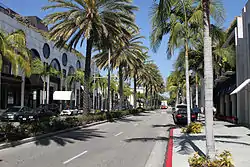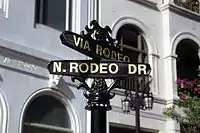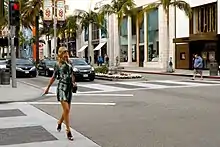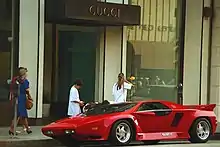Rodeo Drive
Rodeo Drive /roʊˈdeɪoʊ/ is a two-mile-long (3.2 km) street, in Beverly Hills, California, with its southern segment in the City of Los Angeles. Its southern terminus is at Beverwil Drive, and its northern terminus is at its intersection with Sunset Boulevard in Beverly Hills. The name is most commonly used metonymically to refer to the three-block stretch of the street north of Wilshire Boulevard and south of Little Santa Monica Boulevard.
 Rodeo Drive in 2012 | |
| Location | Beverly Hills, California Los Angeles, California |
|---|---|
| Coordinates | 34°4′9.23″N 118°24′10.76″W |
| South end | Beverwil Drive in Los Angeles |
| Major junctions |
|
| North end | Sunset Boulevard in Beverly Hills |
| East | North Beverly Drive |
| West | North Camden Drive |
Pronunciation
The word rodeo as a term referring to the cowboy sports can be pronounced with the stress on either the first (/ˈroʊ.di.oʊ/) or second (/roʊˈdeɪ.oʊ/) syllable; the latter is its Spanish pronunciation.[1] For the street in Beverly Hills, however, only the latter pronunciation is used; the former pronunciation is used to refer to Rodeo Road in Los Angeles, which has since been renamed Obama Boulevard.[2]
History
Early history
In 1906, Burton E. Green (1868–1965) and other investors purchased the property that would become Beverly Hills, formerly named Rancho Rodeo de las Aguas, with plans for a mixed-use subdivision with a branch of the Los Angeles and Pacific Railway running North on Rodeo Drive before turning west at Sunset Boulevard.[3] They platted the street that very year, in 1906.[4] By 1907, 75 ft × 160 ft (23 m × 49 m) parcels on Rodeo were selling for $1,100 each.[5] It became a bridle path in 1912, when the Beverly Hills Hotel was built on a former lima bean field.[4] By November 1925, similar lots were selling for between $15,000 and $30,000, almost double what they'd been selling for in September.[6]

The central part of Rodeo eventually became a business street with hardware stores, gas stations,[7] beauty shops, and bookstores. In 1958, real estate developer Marvin Kratter bought 48,000 square feet (4,500 m2) of land at the corner of Rodeo and Wilshire Boulevard from the city of Beverly Hills.[8] The acreage is across the street from the Beverly Wilshire Hotel and Kratter paid something over $2 million for it.[8]
The men's store Carroll & Company opened shop on Rodeo Drive in 1950.[9]
Origin of a new image
In 1967 Fred Hayman, "the father of Rodeo Drive," opened Giorgio Beverly Hills, the street's first high-end boutique.[7] In 1968 Aldo Gucci opened a store on Rodeo, which catalyzed the process by which the street took on its present form.[10] Van Cleef & Arpels opened in 1969, followed by a Vidal Sassoon salon in 1970. The Polo Store, the brand's first freestanding store, opened in 1971.[11]
According to erstwhile co-chair of the "Rodeo Drive Committee" Richard Carroll, the transformation of Rodeo Drive into an international center of fashionable shopping was sparked in 1971 with the opening of a new wing of the Beverly Wilshire.[12] In 1980 Carroll noted that before then "There was nothing at all of an international nature on the street. Rodeo was purely local in flavor."[12] In 1977 the Rodeo Drive Committee "launched a publicity campaign designed to make everyone around the world think of Rodeo Drive as the shopping street of the rich and famous."[13] The RDC wanted to make Rodeo Drive an economic engine for Beverly Hills and spread the image of a "culturally elite lifestyle."[14]
In 1976, Bijan Pakzad opened a showroom on Rodeo, which helped to solidify "Rodeo Drive's reputation as a luxury shopping destination."[15][16] Pakzad touted his Rodeo Drive store as "the most expensive in the world," but, as Women's Wear Daily notes in relation to the claim, "he was known for hyperbole."[15] By 1978 the Beverly Hills Chamber of Commerce was boasting that Rodeo Drive was "the essence of the best of all the shopping centers of the world"[17] and by 1980 the city of Beverly Hills estimated that the Rodeo Drive shopping district accounted for as much as 25% of its sales tax revenues.[12] The building at 332 N. Rodeo was designed by Frank Lloyd Wright.[18]
International fashion centre

By 1981, the high-fashion strip took up only two and a half blocks, with around 65 stores.[19]
The "Rodeo Collection," a 45-store, 70,000-square-foot (6,500 m2) shopping mall[20] opened in 1983[21] at 421 N. Rodeo Drive. The building is only four stories high with the first floor below street level in order to satisfy local building codes. The retail space initially leased for as much as $120 per square foot, which, according to an executive with commercial real estate firm Julien J. Studley, was "the highest price for any kind of space in the Los Angeles Area."[20]
In the early 1990s, Rodeo Drive was ranked 4th most-visited destination in the Los Angeles area (after Disneyland, Knott's Berry Farm and Universal Studios).[22]
Two Rodeo Drive, another outdoor shopping center, was built in 1990. It initially housed, amongst other stores, Christian Dior and Valentino.[23][24] The original developer, Douglas Stitzel, sold the property for about $200 million immediately after its completion.[23] Two Japanese groups, Kowa Real Estate California Inc. and USA Sogo Inc, bought 40% of Two Rodeo Drive.[22]
The Two Rodeo Drive shopping center was hard-hit by the early 1990s recession, with occupancy rates dropping to as low as 60%.[23] Middle-market brand boutiques such as Guess Jeans and Banana Republic opened on Rodeo Drive.[9] Many franchised stores were bought back by the brands they represented (Polo Ralph Lauren, Gianni Versace, Hugo Boss).[11]
The Two Rodeo Drive buyers sold it at an almost $70 million loss in 2000. By 2007 the property was financially stable again and was sold to a group of Irish investors for $275 million.[23] It resembles a “faux-European shopping alley” and features a cobblestone street.[25] Some architects have claimed that Two Rodeo Drive is similar to a "theme park in the manner of Disneyland."[26]
Walk of Style


In 2003, Rodeo Drive was given an $18 million makeover which included widening the streets and the addition of crosswalks. The ficus trees lining the street were taken out and replaced with palm trees. In September of the same year, the Rodeo Drive Committee developed the Rodeo Drive Walk of Style.[27] The Walk of Style features plaques set in the sidewalks along Rodeo Drive. Fashion icons are honored with the award for their work in style and fashion.[28] At the intersection of Rodeo Drive and Dayton Way is the majestic, nude sculpture entitled "Torso." This famed statue was created by world-renowned sculptor Robert Graham and is the symbol for the Rodeo Drive Walk of Style. Recipients of the Rodeo Drive Walk of Style Award receive a "Torso" maquette also designed by artist Bob Graham.[29]
The French fashion firm Lanvin opened a store on Rodeo Drive in 2011.[30]
2020 lootings
In May 2020, several of Rodeo Drive's famed businesses were damaged and looting following the killing of George Floyd. It was reported the several windows were broken and many of the looted buildings were vandalized by spray paint.[31]
Events
- Rodeo Drive Concours d'Elegance: occurs annually every Father's Day on Rodeo Drive to exhibit some of the world's most expensive automobiles.[32]
- Fashion’s Night Out: Created in 2009 in New York City in hopes of boosting the economy during the recession. Its goals were to "celebrate fashion, restore consumer confidence and boost the industry’s economy." In 2012, 500 cities across the United States (including Los Angeles), as well as 30 cities around the world adopted the event. It is held annually in September on the same night worldwide.[33] The carnival features a 60-foot Ferris wheel and other attractions on the three blocks of the Rodeo Drive business district.[34]
- Rodeo Drive Festival of Watches and Jewelry.[35][36][37]
Notable people
- William Boyd and Elinor Fair, film actors, married to each other[38]
- Nicole Brown and O.J. Simpson first met at Jack Hanson's Rodeo Drive nightclub, The Daisy, when Brown worked there as a waitress[39]
- Tod Browning, film actor, director, and screenwriter (corner of Rodeo Drive and Cañon Drive)[40]
- Ralph Forbes, film actor (606 Rodeo Drive)[41]
In popular culture
- In the 1990 movie Pretty Woman, the young prostitute Vivian Ward (Julia Roberts) steps in a Rodeo Drive boutique where she gets snubbed by the sales clerks.[9]
References
- Fitzpatrick, Kyle (July 14, 2015). "A Local's Guide to Properly Pronouncing L.A. Places". Los Angeles. Retrieved July 27, 2020.
- Pollack, Gina (July 22, 2019). "How To Speak LA: Your Guide To The City's Most Debated And Mispronounced Words". LAist. Retrieved July 27, 2020.
- "New Railroad and New City". Los Angeles Times. November 10, 1906. p. I12.
- Goode, Terrance (Spring 1998). "Rodeo Drive: The History of a "Street of Dreams"". Journal of Architectural and Planning Research. 15 (1): 45–60. JSTOR 43030442.
- "Sales in Beverly Hills". Los Angeles Times. May 19, 1907. p. V20.
- "Realty Values Show Increase:Beverly Hills Lots Reveal Remarkable Gains". Los Angeles Times. November 22, 1925.
- Sandy Cohen (June 8, 2011). "Honors for Fred Hayman, the father of legendary Rodeo Drive". The Daily Star. p. 12.
But back in 1964, when Fred Hayman started building his Giorgio Beverly Hills shop, Rodeo Drive was just a regular city street, with a grocer, a gas station and a hardware store. Hayman became its ambassador. He envisioned the street as an elegant home to the finest designers and boutiques, a magnet for starlets and socialites, like an American Champs-Elysees, a sexy, fun, camera-ready intersection of Hollywood and fashion. Giorgio Beverly Hills, located at 273 Rodeo Drive, boasted its own oak bar and pool table, where gentlemen could pass the time as the ladies shopped. Hayman welcomed browsers with a glass of Champagne. He personally invited celebrity contacts he met at the Hilton to experience his latest business venture, creating an air of sophistication among the clientele.
- "Deal at Beverly Hills: Investor Enlarges Holdings in Coast City Realty". New York Times. February 19, 1958. p. 45.
- Calvin Sims, Hard Times, Even on Rodeo Drive, Nytimes.com, 26 October 1992
- Ilpo Koskinen (Spring 2005). "Semiotic Neighborhoods". Design Issues. 21 (2): 13–27. doi:10.1162/0747936053630142. JSTOR 25223990.(subscription required)
- Frank Swertlow, Los Angeles Business Journal, Labusinessjournal.com, 20 July 1998
- Barbara Baird (June 8, 1980). "Complimentary Cappucino: Shoppers' Street of Dreams is Chic Showcase of Opulence". Los Angeles Times. p. W81.
- Kasindorf, Jeanie (19 November 1984). "Rodeo Drive: Fear of Buying". New York Magazine: 20.
- Goode, T. (1998). "Rodeo Drive: The History of a "Street of Dreams"". Journal of Architectural and Planning Research. 15 (1): 45.
- Brown, Rachel (19 April 2011). "Bijan Pakzad, Rodeo Drive Pioneer". Women's Wear Daily. 201 (80): 6. Retrieved 7 April 2014.(subscription required)
- Khouri, Andrew (August 26, 2016). "Bijan property on Rodeo Drive sells for $19,000 a square foot". Los Angeles Times. Retrieved 28 August 2016.
- Pamela G. Hollie (December 14, 1978). "Glittering Stores For Sheiks, Stars: A Great Westward Migration". New York Times. p. D1.
- "Rodeo Drive—It's 'a giant sundae' and some of the world's most exclusive shops". Los Angeles Times. November 25, 1977. p. J19.
- Elizabeth Bumiller, Rodeo Drive: Mink-Lined Mecca of the Inaugural Set, Washingtonpost.com, 14 January 1981
- Ryon, Ruth (May 25, 1980). "That Glitter in Beverly Hills is Growth of Rodeo Drive". Los Angeles Times. p. I1.
- Darling, Michael (September 9, 2013). "A Rodeo Drive timeline". Los Angeles Times.
- Dave McNary, Japanese make major Rodeo Drive investment, Upi.com, 4 June 1990
- Vincent, Roger (18 September 2007). "Rodeo Drive shopping center sold". Los Angeles Times. Retrieved 4 April 2014.
- Aaron Betsky, Two Rodeo Drive--A Collage of What Beverly Hills Is All About, Latimes.com, 5 December 1991
- Rough Guides (2011). The Rough Guide to California. Penguin, 2011. p. 109.
- David Gebhard (2003). An Architectural Guidebook to Los Angeles. Gibbs Smith. pp. 158–9. ISBN 978-1-58685-308-2.
- Nguyen, Daisy (24 December 2003). "Rodeo Drive Gets Needed Makeover". The Augusta Chronicle. p. A13. Retrieved 1 April 2014.(subscription required)
- Schmidt, Ingrid (5 February 2014). "Designer Catherine Martin to get Rodeo Drive Walk of Style Award". Los Angeles Times. Retrieved 1 April 2014.
- Roug, Louise (4 March 2003). "Armani is first to get star on fashion 'Walk of Style'". Los Angeles Times. Retrieved 1 April 2014.
- Brown, Rachel (31 January 2011). "Lanvin Lands On Rodeo". Women's Wear Daily. 201 (20): 3. Retrieved 7 April 2014.(subscription required)
- https://www.10news.com/news/national-news/looters-target-famed-rodeo-drive-stores-in-beverly-hills
- Garon, Brenton (18 June 2010). "Concours to Honor Event Participants On Father's Day" (PDF). The Beverly Hills Courier. p. 24. Archived from the original (PDF) on 7 April 2014. Retrieved 1 April 2014.
- Hsu, Tiffany (27 February 2013). "Fashion's Night Out, designed to boost economy, goes on hiatus". Los Angeles Times. Retrieved 1 April 2014.
- Yvette, Mar (7 September 2011). "Fashion's Night Out LA 2011: Where To Go For The Best Deals, Steals & Meals". The Huffington Post. Retrieved 1 April 2014.
- Susan Denley, Rodeo Drive Festival of Watches gears up, The Los Angeles Times, October 09, 2013
- 'Rodeo Drive Festival of Watches and Jewelry is Sunday', The Beverly Hills Courier, September 12, 2014, p. 8
- Rodeo Drive: Festival of Watches + Jewelry
- Grace Kingsley (January 12, 1928). "Lubitsch Directs Barrymore". Los Angeles Times. p. A9.
- "The Victims: Nicole Simpson and Ron Goldman". CNN: The O.J. Simpson Pages.
- "Director Buys Beverly Hills Dwelling Site". Los Angeles Times. September 19, 1926. p. E4.
- "Actress's Auto to Be Sold: Ruth Chatterton's Coupe Attached for Lien of $121.50". New York Times. May 29, 1928. p. 11.
